The Honeywell Vista-128BPT is a commercial burglary security system designed for partitioned security solutions․ This guide provides detailed installation instructions to ensure proper setup and functionality․
1․1 What is Vista 128BPT?
The Honeywell Vista-128BPT is a commercial burglary partitioned security system designed for advanced security solutions․ It supports up to 128 wireless zones using an RF receiver and is compatible with various Honeywell security devices․
This system offers robust features like scheduling, partitioning, and integration with other security components․ It is widely used for protecting large premises and provides a reliable security framework․ The Vista-128BPT is known for its expandability and ease of customization to meet specific security needs․ Its installation requires careful planning and adherence to the provided manual for optimal performance․ The system is supported by detailed documentation, including installation guides and user manuals, ensuring smooth setup and operation․
1․2 Importance of Proper Installation
Proper installation of the Vista-128BPT is crucial to ensure optimal performance and reliability․ Incorrect setup can lead to system malfunctions, security vulnerabilities, and potential damage to components․ Unauthorized changes or deviations from the installation manual can void warranties and compromise system integrity․ Following the official Installation Instructions or Users Manual is essential to maintain compliance with safety standards and achieve desired functionality․ Proper installation ensures seamless integration with other security devices, supports up to 128 wireless zones, and guarantees robust protection for the premises․ Adhering to the guidelines ensures the system operates efficiently, providing reliable security solutions and minimizing risks associated with improper configuration․

Pre-Installation Requirements
Ensure system planning, design, and compatibility checks are completed․ Verify power requirements and gather necessary tools and accessories before proceeding with the installation process․
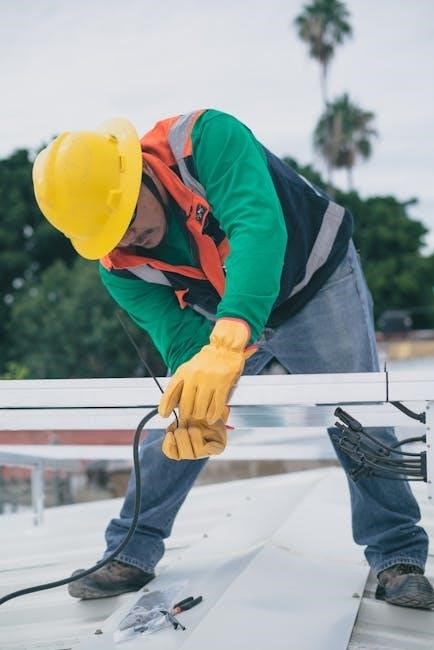
2․1 System Planning and Design
System planning and design are critical to ensure the Vista 128BPT operates efficiently․ Begin by assessing the site’s security requirements, including the number of zones, door access points, and alarm needs․ Create a detailed layout of the system architecture, considering cable routing, device placement, and power distribution․ Plan for future expansion by allowing scalability in the design․ Define user roles and access levels to ensure proper security protocols․ Develop a wiring diagram and zone map to guide the installation process․ Verify that the design complies with local safety regulations and industry standards․ A well-planned system ensures optimal performance, reduces installation errors, and simplifies future upgrades or modifications․
2․2 Compatibility Checks
Ensuring compatibility is essential for the Vista 128BPT system to function seamlessly․ Verify that all hardware components, such as control panels, keypads, and sensors, are compatible with the system’s firmware version․ Check software compatibility with the operating system and any third-party applications․ Confirm that peripheral devices, like cameras or door locks, are supported by the system․ Review the system’s specifications to ensure they align with the site’s electrical and networking infrastructure․ Consult the manufacturer’s compatibility list to avoid integrating unsupported devices․ Address any potential issues, such as outdated firmware or unsupported modules, before proceeding with installation․ Proper compatibility ensures smooth operation and minimizes post-installation issues․ Always refer to the latest documentation for verified hardware and software combinations․
2․3 Power Requirements
The Vista 128BPT system requires a stable power supply to operate efficiently․ Ensure the control panel is connected to a dedicated 12V DC power source with a minimum capacity of 1․5A․ Verify that all peripheral devices, such as keypads and sensors, are powered appropriately․ The system supports a standby power consumption of approximately 250mA, with peak consumption during activation of outputs․ Use a high-quality transformer that meets the system’s specifications to avoid voltage fluctuations․ Proper grounding is essential to prevent electrical interference and ensure reliable operation․ Check the power requirements for additional components, such as wireless receivers or expansion modules, and ensure the power supply can handle the total load․ Always refer to the manufacturer’s specifications for precise power requirements to guarantee system stability and performance․
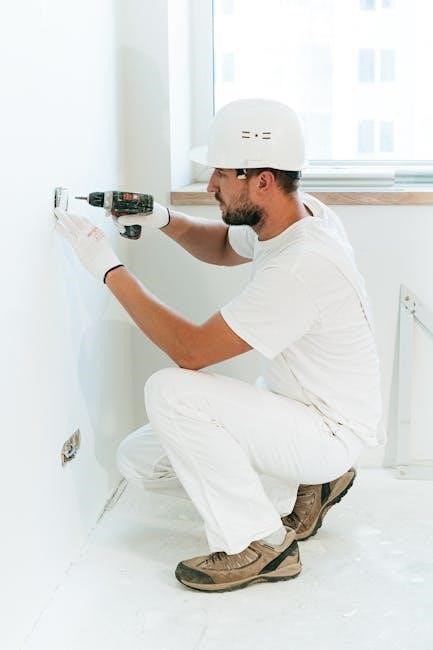
System Components Overview
The Vista 128BPT system consists of hardware, software, and accessories․ The hardware includes control panels, sensors, and peripherals․ Software manages configurations and operations․ Accessories ensure proper installation and functionality, providing a comprehensive security solution․
3․1 Hardware Components
The Vista 128BPT system includes a range of hardware components essential for its operation․ The control panel serves as the central processing unit, managing all system functions and data․ Sensors, such as motion detectors and door contacts, provide intrusion detection․ Keypads and touchscreens enable user interaction for arming, disarming, and configuring the system․ Alarm sirens and strobe lights are included for alerting occupants during breaches․ Power supplies and backup batteries ensure continuous operation during outages․ Communication modules, like GSM and IP modules, facilitate connectivity to monitoring stations․ Wiring, connectors, and mounting brackets are also provided for secure installation․ These components work together to create a robust security solution, ensuring reliable performance and protection․
3․2 Software Components
The Vista 128BPT system relies on several software components to ensure optimal functionality․ The primary operating software is pre-installed on the control panel, managing security protocols, user interfaces, and system integration․ Programming software is used for configuring zones, user codes, and advanced settings, typically accessed via a computer or keypad․ Remote access apps enable smartphone control, allowing users to monitor and manage the system from anywhere․ Firmware updates are periodically released to enhance features, fix bugs, and improve security․ Additionally, integration software facilitates compatibility with third-party systems, such as home automation devices․ These software elements work seamlessly together to provide a secure, user-friendly, and adaptable security solution, ensuring the system remains up-to-date and fully functional․ Regular updates are essential to maintain performance and security․
3․3 Accessories and Tools Needed
Installing the Vista 128BPT system requires specific accessories and tools to ensure a smooth setup․ Essential tools include screwdrivers, drills, and wire strippers for hardwiring components․ Mounting hardware like brackets and screws are necessary for securing the control panel and sensors․ Additionally, backup batteries and power supplies are crucial for uninterrupted operation․ Specialized tools, such as a programming keypad, may be needed for advanced configurations․ Cables and connectors are also essential for connecting peripheral devices․ Lastly, extra materials like adhesive strips and labels can aid in organizing the installation․ Having these tools and accessories readily available ensures the installation process is efficient and trouble-free․

Installation Process
The Vista 128BPT installation involves multiple phases, including preparation, hardwiring, and system configuration․ Proper sequencing ensures all components function seamlessly, requiring careful attention to instructions and testing․
4․1 Hardwiring the System
Hardwiring the Vista 128BPT involves connecting sensors, keypads, and other devices to the control panel․ Start by planning the wire layout to minimize interference and ensure all zones are reachable․ Use high-quality, shielded cables (e․g․, CAT5 or 18 AWG) for reliable signal transmission․ Connect each sensor to the appropriate zone terminals on the control panel, following the wiring diagram provided in the manual․ Ensure all connections are secure and free from short circuits․ For keypads and other peripheral devices, use twisted-pair cables to reduce noise․ After wiring, test each connection to confirm proper functionality․ Always disconnect power before making or breaking connections to avoid damage or electrical shock․ Follow local electrical codes and safety guidelines during installation․ Proper hardwiring is critical for system performance and reliability․
4․2 Wireless Zone Setup
Setting up wireless zones on the Vista 128BPT involves configuring wireless devices such as keyfobs, motion detectors, and door sensors․ Begin by enabling wireless mode on the control panel and ensuring all devices are powered on․ Use the system’s enrollment process to sync each wireless device with the panel, following the manufacturer’s pairing instructions․ Test signal strength by placing devices in their intended locations and adjusting as needed for optimal connectivity․ Ensure devices are within the recommended range and avoid physical barriers that could weaken signals․ After setup, perform a system test to verify all zones are functioning correctly․ Wireless zones offer flexibility and convenience, eliminating the need for hardwiring while maintaining reliable performance․ Always refer to the device specifications for compatibility and range requirements․
4․3 Mounting the Control Panel
Mounting the Vista 128BPT control panel requires careful planning to ensure optimal performance and security․ Choose a central location with reliable power access, avoiding areas prone to tampering․ Ensure the panel is at a comfortable height for user access while maintaining security․ Use appropriate wall anchors based on wall type (drywall, wood, etc․) to secure the panel firmly․ Align the panel straight using a level and connect all wires neatly to prevent damage․ After installation, test the system to confirm all zones are functioning correctly․ Ensure power is turned off during installation to prevent electrical hazards․ For complex setups, consider consulting a professional․ Proper mounting ensures reliable operation and enhances system effectiveness․
4․4 Connecting Peripheral Devices
Connecting peripheral devices to the Vista 128BPT system is a critical step for full functionality․ Start by identifying the appropriate ports on the control panel for each device, such as keypads, motion detectors, sirens, and door contacts․ Use the correct wiring (e․g․, 4-wire or 2-wire) for each device, ensuring proper termination․ For keypads, connect the RS-485 bus, while sensors typically use normally open (NO) or normally closed (NC) connections․ Power down the system before connecting any device to avoid damage․ Once connected, test each device to ensure proper communication with the control panel․ Refer to the device manuals for specific wiring requirements․ Organize cables neatly to prevent interference and ensure easy maintenance․ Always follow safety guidelines when handling electrical components․

Configuration and Setup
Configure the Vista 128BPT system by initializing settings, programming zones, and setting user access levels․ Use the control panel or software tools for precise setup and optimization․
5․1 Initial System Configuration
The initial system configuration of the Vista 128BPT involves setting up the basic operational parameters․ Begin by powering on the control panel and following the startup wizard․ Enter the system date, time, and security codes as required․ Initialize zones by assigning names and types (e․g․, perimeter, interior) based on your security needs․ Configure the system to recognize all connected sensors and devices․ Set up arming and disarming options, including master and user codes; Review and save all settings to ensure proper functionality․ Refer to the control panel manual for detailed instructions on navigating the menu and customizing settings․ Proper initial configuration ensures reliable performance and tailored security for your premises․
5․2 Zone Programming
Zone programming defines how each monitored area interacts with the Vista 128BPT system․ Begin by identifying and labeling zones based on their location or function, such as “Front Door” or “Living Room Window․” Assign each zone a type (e․g․, entry/exit, perimeter, or interior) to determine its behavior․ Set sensitivity levels for motion detectors and adjust delay times for entry/exit zones․ Define how the system responds to breaches, such as sounding an alarm or sending notifications․ Use the control panel or programming software to assign these settings․ Ensure all zones are tested to confirm proper functionality․ Proper zone programming ensures the system reacts appropriately to different scenarios, enhancing security and reducing false alarms․ Refer to the user manual for specific codes or commands required during this process․
5․3 User Access Levels
User access levels define the permissions for individuals interacting with the Vista 128BPT system․ Administrators can create multiple user profiles, each with unique access codes and privileges․ Common levels include “Administrator,” “Manager,” and “User,” with varying degrees of control․ Administrators can modify system settings, add/remove users, and view event logs, while Managers may only arm/disarm the system or view limited data․ Basic Users typically have restricted access, such as arming/disarming specific zones․ Access levels ensure that only authorized individuals can perform critical functions, enhancing system security․ Use the control panel or programming software to assign these levels․ Secure access codes and regularly update permissions to maintain system integrity and prevent unauthorized access․ This feature is essential for managing multiple users in residential or commercial settings․
5․4 Integration with Other Systems
The Vista 128BPT can seamlessly integrate with various systems to enhance functionality․ Compatibility with home automation systems allows control of lighting, thermostats, and security cameras through a single interface․ Integration with CCTV systems enables video verification of alarms, improving response times․ Additionally, the system supports voice control via smart speakers and works with environmental sensors for comprehensive monitoring․ Communication modules, such as RS-232 or IP modules, facilitate integration with third-party devices․ This versatility ensures the Vista 128BPT adapts to diverse security and automation needs․ Proper configuration during setup is crucial for smooth integration․ Consult the manufacturer’s compatibility list for supported devices․ Integration enhances system performance and provides a unified security solution for residential and commercial applications․
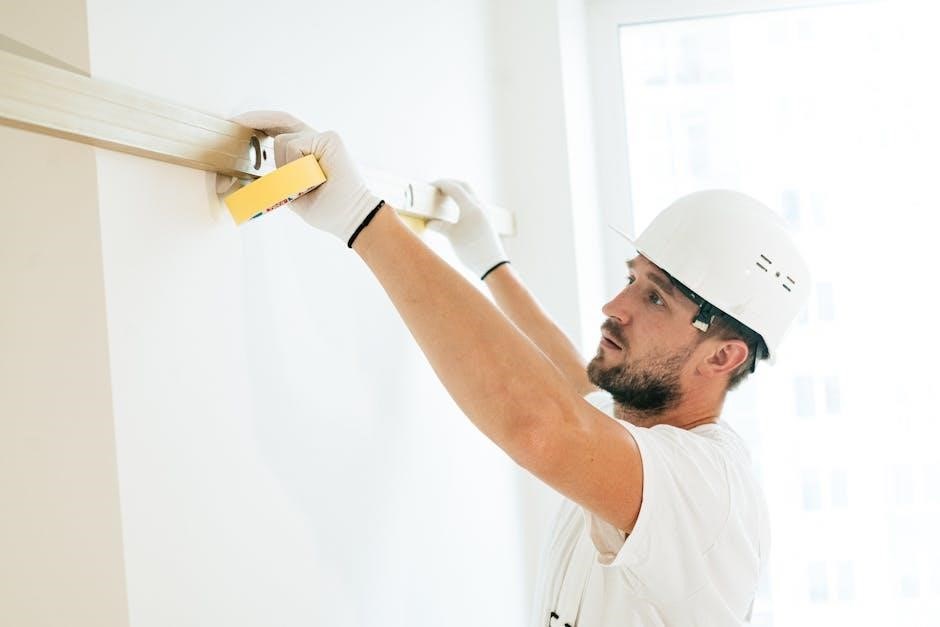
Troubleshooting Common Issues
The Vista 128BPT may encounter issues like system malfunctions or error messages․ Identify problems through logs or LED indicators․ Basic troubleshooting steps include checking connections, restarting the system, and verifying configurations․ For complex issues, consult the manual or contact support․
6․1 Diagnosing Hardware Failures
Diagnosing hardware failures in the Vista 128BPT involves identifying faulty components․ Start by checking for error messages or unusual system behavior․ Inspect connections and wiring for damage or loose links․ Use the control panel’s LED indicators to pinpoint issues, as they often flash patterns corresponding to specific problems․ Verify power supply to all components, as low voltage can cause malfunctions․ Utilize the system’s diagnostic logs to trace hardware-related errors․ If a component fails, such as a keypad or sensor, isolate it and test independently․ For advanced troubleshooting, use a multimeter to check circuit continuity or voltage levels․ If issues persist, replace the faulty hardware with compatible parts․ Always refer to the manufacturer’s guidelines for replacement procedures to avoid further damage․
6․2 Resolving Software Glitches
Resolving software glitches in the Vista 128BPT involves addressing issues like system freezes, error messages, or failed updates․ Begin by restarting the system to clear temporary faults․ Check for software updates and install the latest version to fix bugs․ If the system fails to boot, use the recovery mode to restore previous settings․ Inspect error logs for specific codes, which can help identify the root cause․ Verify that all software components are compatible with the hardware․ Reinstalling the software may be necessary if corruption is detected․ Ensure proper network connectivity, as poor connections can trigger glitches․ For persistent issues, contact technical support with error details for advanced troubleshooting․ Always follow manufacturer guidelines to avoid further system instability․ Regular backups can prevent data loss during software repairs․
6․3 Network Connectivity Problems
Network connectivity issues can disrupt communication between the Vista 128BPT system and other devices․ Common problems include failed IP address assignments, poor network signal strength, or incorrect subnet configurations․ Start by verifying all physical connections, such as Ethernet cables or Wi-Fi links, to ensure they are secure․ Restart routers or switches to refresh the network․ Use diagnostic tools like ping tests to identify communication issues․ Check firewall settings to ensure they are not blocking necessary ports․ If the system is wired, test with a different cable to rule out faults․ For wireless setups, ensure the correct SSID and password are entered․ Consult the network configuration guide for specific settings․ If problems persist, contact the manufacturer’s support team for assistance․ Regularly updating network drivers and firmware can also prevent recurring issues․
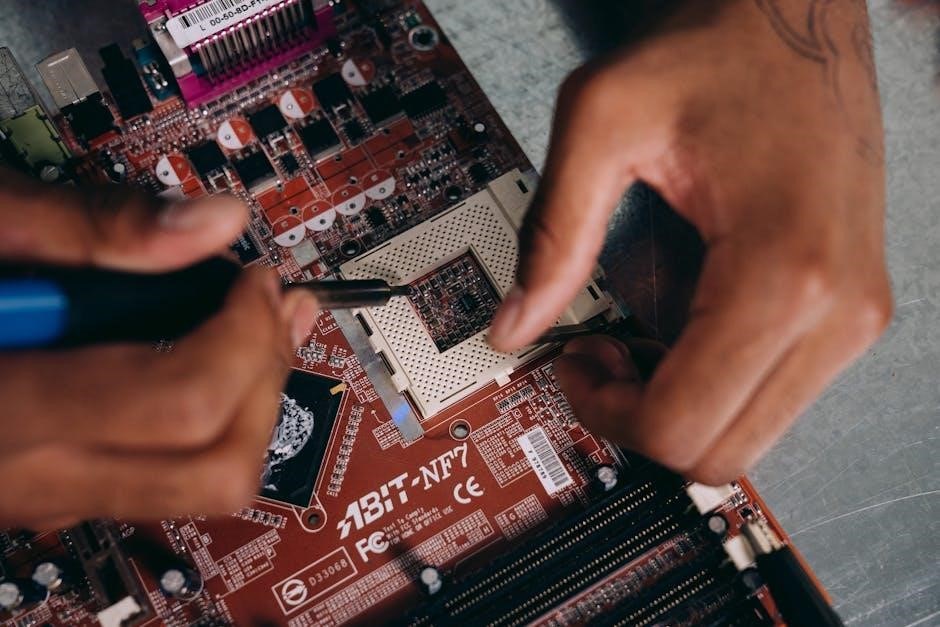
Maintenance and Updates
Regular maintenance ensures the Vista 128BPT system operates efficiently․ Perform routine checks, update software, and verify system integrity to maintain optimal performance and security․ Schedule updates wisely․
7․1 Routine System Maintenance
Regular maintenance is crucial to ensure the Vista 128BPT system operates reliably and securely․ Start by cleaning the control panel and peripheral devices to prevent dust buildup․ Perform monthly inspections of wiring and connections to identify loose or damaged components․ Schedule periodic backups of system settings and user data to avoid loss in case of failures․
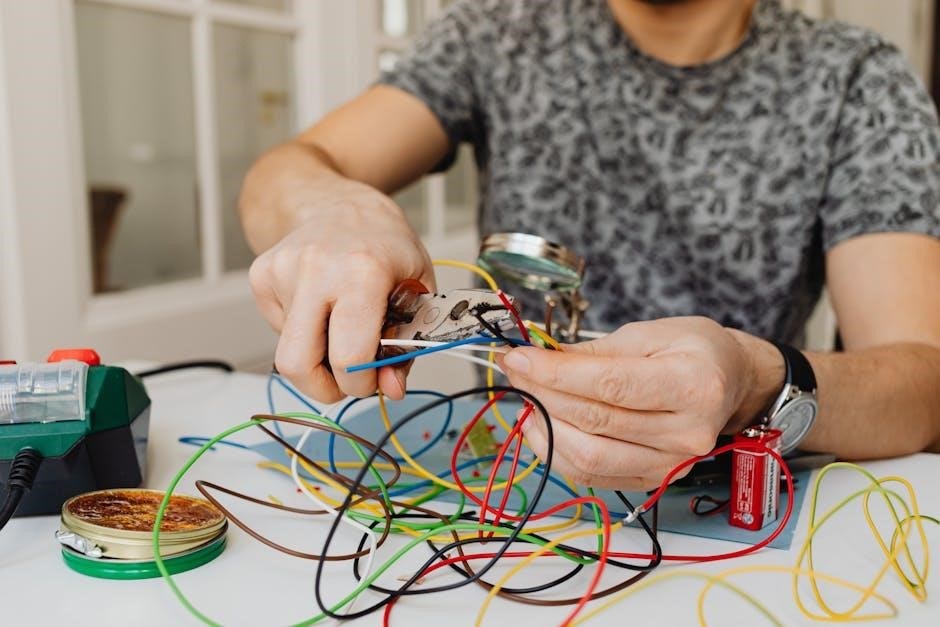
- Clean the control panel and peripherals regularly․
- Inspect wiring for damage or loose connections․
- Backup system settings and user data periodically․
Additionally, check for software updates and apply patches to maintain system security and functionality․ Test sensor responsiveness and ensure all zones are functioning correctly․ Refer to the manual for specific maintenance schedules and procedures․
7․2 Software Updates and Patches
Keeping the Vista 128BPT software up-to-date is essential for optimal performance and security․ Regularly check for updates via the system’s menu or the manufacturer’s website․ Download and install patches to fix bugs, enhance features, and improve compatibility․ Always back up system configurations before applying updates to prevent data loss․
- Check for updates through the system menu or manufacturer’s portal․
- Download and install patches to improve functionality and security․
- Backup configurations before applying updates․
- Restart the system after installation to ensure changes take effect․
Enable automatic update notifications if available to stay informed about new releases․ Refer to the manual for detailed instructions on updating procedures and troubleshooting post-update issues․
7․3 Backup and Recovery Procedures
Regular backups are crucial to ensure the Vista 128BPT system’s integrity and quick recovery in case of failures․ Backup all configurations, user settings, and event logs before performing updates or maintenance․ Use the system menu or compatible software tools to create backups․
- Perform full system backups periodically or before major changes․
- Store backups on external devices or secure cloud storage․
- Test backup files to ensure data integrity and accessibility․
Recovery involves restoring the system to a previous state using saved backups․ Follow the system’s restore menu option and enter admin credentials to complete the process․ Verify all settings and functionality post-recovery․ If issues persist, contact technical support for assistance․

Additional Resources and References
Refer to the official Vista 128BPT documentation, online forums, and technical support for further guidance and troubleshooting․ Utilize user manuals and contact support for assistance․
8․1 Manufacturer Support and Documentation
The manufacturer provides comprehensive support and detailed documentation for the Vista 128BPT system․ Users can access official installation manuals, technical guides, and troubleshooting resources on the manufacturer’s website․ These documents are designed to assist with installation, configuration, and maintenance, ensuring a smooth setup process․ Additionally, the manufacturer offers direct support through phone, email, or live chat for addressing specific issues or clarifying doubts․ The documentation includes step-by-step instructions, diagrams, and best practices to help users maximize system performance․ Regularly updated, these resources reflect the latest features and improvements․ Utilizing manufacturer-provided materials ensures compliance with best practices and minimizes potential errors during installation or operation․
8․2 Online Forums and Communities
Online forums and communities are invaluable resources for Vista 128BPT users seeking peer support and shared knowledge․ Platforms like Reddit, specialized security forums, and manufacturer-hosted communities offer spaces for discussing installation challenges, troubleshooting tips, and best practices․ Users can engage with experienced installers and technicians, gaining insights from real-world applications․ These forums often feature detailed threads on common issues, workarounds, and optimization techniques․ Active participation in these communities can enhance your understanding of the system and expedite problem resolution․ Additionally, many forums provide access to user-generated guides, scripts, and tools that complement the official documentation․ Engaging with these communities fosters a collaborative environment where knowledge is freely shared, benefiting both novice and advanced users alike․ This collective expertise can be a powerful supplement to the manufacturer’s official support channels․
8․3 Professional Installation Services
For a seamless and efficient setup, consider utilizing professional installation services․ Certified technicians specializing in Vista 128BPT systems can ensure optimal performance and compliance with manufacturer guidelines․ These experts handle complex configurations, troubleshoot potential issues, and provide personalized solutions tailored to your security needs․ Professional services often include post-installation support, system testing, and maintenance, ensuring long-term reliability․ They also offer guidance on advanced features and integration with other systems․ To find authorized installers, visit the manufacturer’s website or contact local certified providers․ Professional installation guarantees a worry-free experience, leveraging their expertise to maximize your system’s capabilities and ensure compliance with warranty requirements․ This service is especially recommended for large-scale or intricate setups, where precision and reliability are critical․

